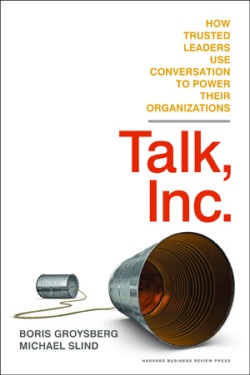In our experience, it’s rare for a diverse group of headstrong Executive Education participants from around the globe to agree on anything. Yet earlier this month, when we surveyed a group of leaders who attended the Driving Performance Through Talent Management program at Harvard Business School, 92% agreed that the practice of internal communication “has undergone a lot of change” at their companies “in recent years.”
While the sample size in this case isn’t large — about three-dozen leaders took part in the survey — these participants make up a highly representative group. They hail from every part of the globe, and from organizations small and large (with head counts that range from about 200 to more than 100,000). They occupy senior positions in fields that include sales and talent management, and they work in industries that range from manufacturing to health care to financial services.
That survey result reinforces a finding that we’ve observed elsewhere in our research: In company after company, the patterns and processes by which people communicate with each other are unmistakably in flux. The old “corporate communication” is giving way to a model that we call “organizational conversation.” That shift is, for many people, a disorienting process. But it also offers a great leadership opportunity.
Our research has shown that more and more leaders — from organizations that range from computer-networking giant Cisco Systems to Hindustan Petroleum, a large India-based oil supplier — are using the power of organizational conversation to drive their company forward. For these leaders, internal communication isn’t just an HR function. It’s an engine of value that boosts employee engagement and improves strategic alignment.
Broadly speaking, there are four steps that you can take to make your approach to leadership more conversational. (In future posts, we will address each of these points at greater length.)
1. Close the gap between you and your employees. In our survey, we also asked respondents to name the biggest employee communication challenge at their company. In response, one participant cited the need to “move away from top-down communication.” Another highlighted a “disparity between the senior management team and middle management due to low transparency.” Trusted and effective leaders overcome such challenges by speaking with employees in ways that are direct, personal, open, and authentic.
2. Promote two-way dialogue within your company. One survey respondent lamented “a lack of understanding in management of the need for communication,” adding that “the traditional practice” of communication at his or her company “has been one-way.” Leaders can show that they appreciate the value of real communication by adopting channels that allow ideas to move in multiple directions across their organization, and by working to create a truly conversational culture within that organization.
3. Engage employees in the work of telling the company story. The need “to get more participation from employees,” according to one respondent, is a pressing challenge at his or her company. People in that company “tend to shy away from speaking openly.” The practice of organizational conversation alters that dynamic. Where that practice has taken hold, leaders encourage broad-based employee involvement in a wide array of communication efforts.
4. Pursue a clear agenda. One participant expressed concern about a “lack of consistency” in communication. Another mentioned a tendency among top leaders to generate “too much communication.” Yet another voiced this complaint: “The strategy is only discussed at the management level and is never cascaded to all staff.” To deal with such challenges — to prevent the communication process from becoming diffuse and ad hoc — effective leaders take steps to ensure that their conversation with employees unfolds according to a clear strategic plan. They also seek to align that conversation with organizational objectives.
Underlying these four elements of organizational conversation is a deeper emerging truth: Leadership is conversation. So start that conversation now.
[Cross-posted on the Harvard Business Review site. Quite a few readers of that post offered comments on it—and we, in turn, posted several comments in reply. Note, by the way, that we’ll follow up this post with items that give HBR.org readers a bit more insight into each of the four elements of organizational conversation.]


sayitbetterkare
/ 06/01/2012Excellent column, Michael and Boris, and I really look forward to reading your book out later this month, Talk Inc.
For conversation in an organization to become trusted, productive communication I’d suggest these elements are also necessary:
1. Craft One Clear Top Goal for the Organization: State it so plainly that everyone in the firm understands and remembers it. That way it becomes the context in which to make decisions, and as a reference point in discussing “first things first” in conversation
2. Support Specificity: Since the specific example proves the general conclusion, and not the reverse, be specific as to needed information, action sought or other communication goal.
3. Encourage all messages to be almost as vital as air, giving them the three elements of A.I.R.:
Be actionable.
Have Interestingness.
Be Relevant
4. Establish Rules of Engagement: Explicitly stated and followed guidelines, set at the top. Cover level candor, transparency and who gets to participate on decision-making conversations and how they can participate
5. Consistently and specifically praise actions inside and outside the firm that support the above four elements. http://www.sayitbetter.com/
Mike
/ 06/01/2012Thank you for your comprehensive comment, Kare. Each of your bullet points relates closely to ideas that we develop in “Talk, Inc.” Your first point, for example, corresponds to the element that we call “intentionality” (captured in this post by the phrase “Pursue a clear agenda”): A good conversation must be *about* something, and organizational conversation must ultimately be about—or in alignment with—the strategic goals of an organization.